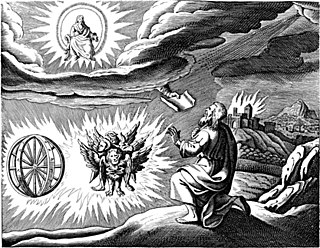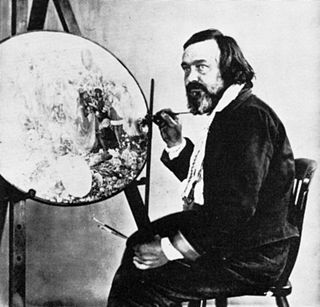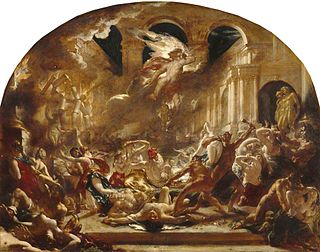
Angels have appeared in works of art since early Christian art, and they have been a popular subject for Byzantine and European paintings and sculpture.

Richard Dadd was an English painter of the Victorian era, noted for his depictions of fairies and other supernatural subjects, Orientalist scenes, and enigmatic genre scenes, rendered with obsessively minuscule detail. Most of the works for which he is best known were created while he was a patient in Bethlem and Broadmoor hospitals.

Joseph Mallord William Turner, known in his time as William Turner, was an English Romantic painter, printmaker and watercolourist. He is known for his expressive colouring, imaginative landscapes and turbulent, often violent marine paintings. He left behind more than 550 oil paintings, 2,000 watercolours, and 30,000 works on paper. He was championed by the leading English art critic John Ruskin from 1840, and is today regarded as having elevated landscape painting to an eminence rivalling history painting.

Sir Edwin Landseer Lutyens was an English architect known for imaginatively adapting traditional architectural styles to the requirements of his era. He designed many English country houses, war memorials and public buildings. In his biography, the writer Christopher Hussey wrote, "In his lifetime (Lutyens) was widely held to be our greatest architect since Wren if not, as many maintained, his superior". The architectural historian Gavin Stamp described him as "surely the greatest British architect of the twentieth century".

The National Gallery is an art museum in Trafalgar Square in the City of Westminster, in Central London, England. Founded in 1824, it houses a collection of more than 2,300 paintings dating from the mid-13th century to 1900. The current director of the National Gallery is Gabriele Finaldi.

Dame Jocelyn Barbara Hepworth was an English artist and sculptor. Her work exemplifies Modernism and in particular modern sculpture. Along with artists such as Ben Nicholson and Naum Gabo, Hepworth was a leading figure in the colony of artists who resided in St Ives during the Second World War.

Liverpool Metropolitan Cathedral, officially known as the Metropolitan Cathedral of Christ the King and locally nicknamed "Paddy's Wigwam", is the seat of the Archbishop of Liverpool and the mother church of the Roman Catholic Archdiocese of Liverpool in Liverpool, England. The Grade II* Metropolitan Cathedral is one of Liverpool's many listed buildings.

John Egerton Christmas Piper CH was an English painter, printmaker and designer of stained-glass windows and both opera and theatre sets. His work often focused on the British landscape, especially churches and monuments, and included tapestry designs, book jackets, screen prints, photography, fabrics and ceramics. He was educated at Epsom College and trained at the Richmond School of Art followed by the Royal College of Art in London. He turned from abstraction early in his career, concentrating on a more naturalistic but distinctive approach, but often worked in several different styles throughout his career.
Graham Vivian Sutherland was a prolific English artist. Notable for his paintings of abstract landscapes and for his portraits of public figures, Sutherland also worked in other media, including printmaking, tapestry and glass design.

Chris Gollon (1953–2017) was a British artist.

Bryan Charnley was a British artist who had paranoid schizophrenia, and explored its effects in his work. He committed suicide in July 1991.

Charles Henry Sims was a British figurative painter known for his portraits and landscapes. He initially became renowned as a leading Edwardian painter, but following the death of his son in World War I, his work became increasingly idiosyncratic, surreal and controversial. In 1920, he was appointed Keeper, or head, of the Royal Academy Schools, a post he was eventually forced to resign in 1926. At the same time, he became estranged from his wife and children. Sims' final paintings, the Spiritual Ideas, were to some viewers his "most beautiful works," but to others highly disturbing. He died by suicide in 1928.

John Ronald Craigie Aitchison CBE RSA RA was a Scottish painter. He was best known for his many paintings of the Crucifixion, one of which hangs behind the altar in the chapter house of Liverpool Cathedral, Italian landscapes, and portraits. His simple style with bright, childlike colours defied description, and was compared to the Scottish Colourists, primitivists or naive artists, although Brian Sewell dismissed him as "a painter of too considered trifles".
George Mayer-Marton was a Hungarian Jewish artist who was a significant figure in Viennese art between the First and Second World Wars, working in oil, watercolour and graphics. Following his forced emigration to England in 1938, he continued to paint in watercolour and oil. He pioneered the technique of Byzantine mosaic in the UK.

Edward Adamson was a British artist, "the father of Art Therapy in Britain", and the creator of the Adamson Collection.

William Logsdail was a prolific English landscape, portrait, and genre painter. He exhibited at the Royal Academy, the Royal Society of British Artists, the Grosvenor Gallery, the New Gallery (London), and others. He is notable for his realistic London and Venice scenes and his plein air style.

St Paul's Bow Common is a 20th-century church in Bow Common, London, England. It is an Anglican church in the Diocese of London. The church is at the junction of Burdett Road and St Paul's Way in the London Borough of Tower Hamlets. It replaced an earlier church that was designed by Rohde Hawkins in 1858 and financed by William Cotton of Leytonstone. Consecrated by Bishop Charles James Blomfield, this church was largely destroyed in the Second World War and demolished in the 1950s.

The Bethlem Gallery is an art gallery in Beckenham, Bromley, England. It was established in 1997 to support and exhibit artists who are current or former patients of the South London and Maudsley NHS Foundation Trust. The gallery is housed in an Art Deco building shared with the Bethlem Museum of the Mind, with exhibits about the history of Bethlem Royal Hospital.

Bethlem Museum of the Mind is a museum focusing on the history of Bethlem Royal Hospital, its programme of care, and its patients. Opened in 2015, the museum is housed in an Art Deco building shared with the Bethlem Gallery, which hosts exhibitions of contemporary artists who are current or former patients.

The Destroying Angel and Daemons of Evil Interrupting the Orgies of the Vicious and Intemperate, also known as The Destroying Angel and Daemons Inflicting Divine Vengeance on the Wicked and Intemperate and as The Destruction of the Temple of Vice, is an 1832 English oil painting on canvas by English artist William Etty, first exhibited in 1832. Etty had become famous for nude paintings, and acquired a reputation for tastelessness, indecency and a lack of creativity. With The Destroying Angel he hoped to disprove his critics with an openly moral piece. The painting is 127.8 cm by 101.9 cm and depicts a classical temple under attack from a destroying angel and a group of daemons. Some of the humans appear dead or unconscious, others flee or struggle against the daemons.





















